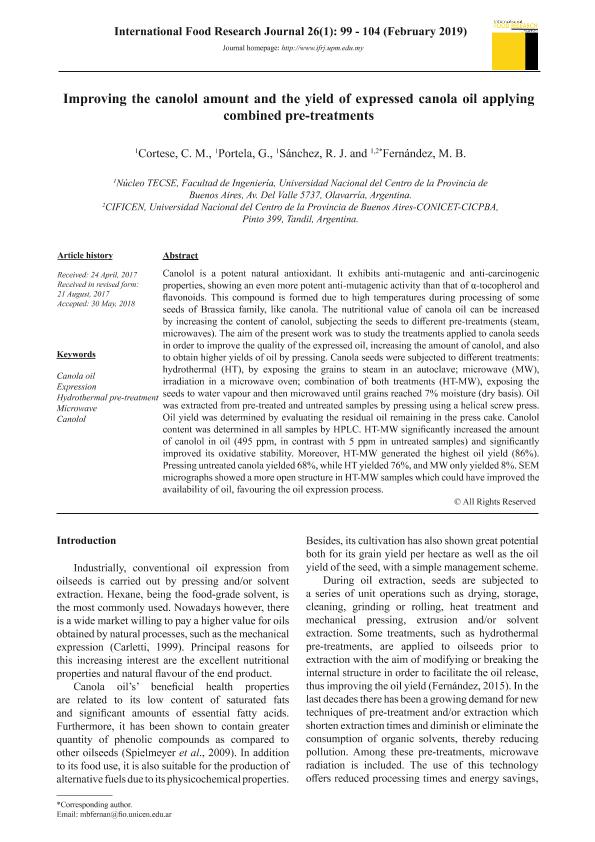Mostrar el registro sencillo del ítem
dc.contributor.author
Cortese, C.M.
dc.contributor.author
Portela, G.
dc.contributor.author
Sánchez, Ramiro Julián

dc.contributor.author
Fernández, María Belén

dc.date.available
2020-08-14T15:29:38Z
dc.date.issued
2018-05
dc.identifier.citation
Cortese, C.M.; Portela, G.; Sánchez, Ramiro Julián; Fernández, María Belén; Improving the canolol amount and the yield of expressed canola oil applying combined pretreatments; Universiti Putra Malaysia. Faculty of Food Science and Technology; International Food Research Journal; 26; 1; 5-2018; 99-104
dc.identifier.issn
1985-4668
dc.identifier.uri
http://hdl.handle.net/11336/111763
dc.description.abstract
Canolol is a potent natural antioxidant. It exhibits antimutagenic and anticarcinogenic properties, showing an even more potent antimutagenic activity than that of α-tocopherol and flavonoids. This compound is formed due to high temperatures during processing of some seeds of brassica family, like canola. The nutritional value of canola oil can be increased by increasing the content of canolol, subjecting the seeds to different pretreatments (steam, microwaves). The aim of this work was to study treatments applied to canola seeds in order to improve the quality of the expressed oil, increasing the amount of canolol, and also to obtain higher yields of oil by pressing. Canola seeds were subjected to different treatments: -Hydrothermal (HT), by exposing the grains to steam in an autoclave; -Microwave (MW), irradiation in a microwave oven; Combination of both treatments (HT-MW): exposing the seeds to water vapor and then microwave irradiating until grains reached a 7% moisture, dry basis. Oil was extracted from pretreated and untreated samples by pressing using a helical screw press. Oil yield was determined by evaluating the residual oil remaining in the press cake. Canolol content was determined in all samples by HPLC. The combined pretreatment HT-MW significantly increased the amount of canolol in oil (495ppm in contrast with 5ppm in untreated samples) and significantly improved its oxidative stability. Moreover, this pretreatment generated the highest oil yield by expression, extracting 86% of the total oil. While, by pressing untreated canola, 68% of the total oil in grains was obtained, in hydrothermally pretreated samples it was extracted a 76% of the oil and 8% in the case of only irradiated with microwaves samples. Furthermore, SEM micrographs showed a more open structure in samples treated by combined pretreatment HT-MW, which could have improved the availability of oil, favoring the oil expression process.
dc.format
application/pdf
dc.language.iso
eng
dc.publisher
Universiti Putra Malaysia. Faculty of Food Science and Technology
dc.rights
info:eu-repo/semantics/openAccess
dc.rights.uri
https://creativecommons.org/licenses/by-nc-sa/2.5/ar/
dc.subject
CANOLA OIL
dc.subject
EXPRESSION
dc.subject
HYDROTHERMAL PRETREATMENT
dc.subject
MICROWAVE
dc.subject
CANOLOL
dc.subject.classification
Alimentos y Bebidas

dc.subject.classification
Otras Ingenierías y Tecnologías

dc.subject.classification
INGENIERÍAS Y TECNOLOGÍAS

dc.title
Improving the canolol amount and the yield of expressed canola oil applying combined pretreatments
dc.type
info:eu-repo/semantics/article
dc.type
info:ar-repo/semantics/artículo
dc.type
info:eu-repo/semantics/publishedVersion
dc.date.updated
2020-01-29T22:36:27Z
dc.journal.volume
26
dc.journal.number
1
dc.journal.pagination
99-104
dc.journal.pais
Malasia

dc.description.fil
Fil: Cortese, C.M.. Universidad Nacional del Centro de la Provincia de Buenos Aires. Facultad de Ingeniería Olavarría. Grupo Tecnologías de Semillas; Argentina
dc.description.fil
Fil: Portela, G.. Universidad Nacional del Centro de la Provincia de Buenos Aires. Facultad de Ingeniería Olavarría. Grupo Tecnologías de Semillas; Argentina
dc.description.fil
Fil: Sánchez, Ramiro Julián. Universidad Nacional del Centro de la Provincia de Buenos Aires. Centro de Investigaciones en Física e Ingeniería del Centro de la Provincia de Buenos Aires. - Consejo Nacional de Investigaciones Científicas y Técnicas. Centro Científico Tecnológico Conicet - Tandil. Centro de Investigaciones en Física e Ingeniería del Centro de la Provincia de Buenos Aires. - Provincia de Buenos Aires. Gobernación. Comisión de Investigaciones Científicas. Centro de Investigaciones en Física e Ingeniería del Centro de la Provincia de Buenos Aires; Argentina. Universidad Nacional del Centro de la Provincia de Buenos Aires. Facultad de Ingeniería Olavarría. Grupo Tecnologías de Semillas; Argentina
dc.description.fil
Fil: Fernández, María Belén. Universidad Nacional del Centro de la Provincia de Buenos Aires. Centro de Investigaciones en Física e Ingeniería del Centro de la Provincia de Buenos Aires. - Consejo Nacional de Investigaciones Científicas y Técnicas. Centro Científico Tecnológico Conicet - Tandil. Centro de Investigaciones en Física e Ingeniería del Centro de la Provincia de Buenos Aires. - Provincia de Buenos Aires. Gobernación. Comisión de Investigaciones Científicas. Centro de Investigaciones en Física e Ingeniería del Centro de la Provincia de Buenos Aires; Argentina. Universidad Nacional del Centro de la Provincia de Buenos Aires. Facultad de Ingeniería Olavarría. Grupo Tecnologías de Semillas; Argentina
dc.journal.title
International Food Research Journal
dc.relation.alternativeid
info:eu-repo/semantics/altIdentifier/url/http://www.ifrj.upm.edu.my/26%20(01)%202019/(10).pdf
dc.relation.alternativeid
info:eu-repo/semantics/altIdentifier/url/http://www.ifrj.upm.edu.my/ifrj-2019-26-issue-1.html
Archivos asociados
